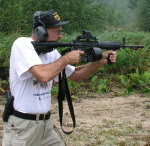- According to published reports, the first police officer was on scene in 29 seconds, and there were 10 officers within 90 seconds
- 48 rounds of 9MM and 6 shotguns rounds were fired killing 5 people plus the gunman - all in about 2 minutes
- The shooter was reported to have had mental problems and had discontinued taking anti-depressants because they made him feel like a zombie
I believe that the only thing that could have saved any of these students was that if some of them had been armed and trained in what to do in that situation. There has been talk of allowing teachers to carry concealed weapons and I generally agree with that if they have the proper mindset and training.
There is a giant risk to a civilian engaging the shooter in this situation. We are trained in law enforcement to immediately find the shooter and stop the threat - and even step over wounded students if need be. The adrenaline will be flowing and the problem is one of target identification - who is the good guy and who is the bad guy? If you are the civilian is this situation you will probably be so focused on the shooter that you may not see the police or hear their commands.
Don't get my wrong, I'm not saying to do nothing. I'm just cautioning you to be fully aware of your surroundings and to be looking for law enforcement to arrive. We are trained to enter with at least 4 people in a diamond or stack formation and this should be pretty obvious. I hope there comes a day when we read a report where the shooter is the only one killed or injured.
